paleomaxx
Hero Member
- Joined
- Aug 14, 2016
- Messages
- 841
- Reaction score
- 6,888
- Golden Thread
- 6
- Location
- Upstate, NY
- 🥇 Banner finds
- 6
- Detector(s) used
- Deus XP
- Primary Interest:
- All Treasure Hunting
!!!Update on Sword Guard Below!!!
Didn't have a lot of time to detect and I wasn't expecting to find much. There's a spot in the hills I found a year or so back with two 18th century foundations right next to an old road and maybe 150 feet apart. Both had been detected before, but they're super trashy since they were a party spot in the 60s so I usually find a mid tone or two that actually end up being old.
This time I was checking the ground between the two which I was hoping would have had a little traffic 200 years ago. Almost in the middle of the two was a weird single line pile of rocks and right next to that pile I pulled out a super deep high tone:
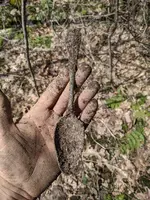
An intact 18th century pewter spoon! I had been expecting a large chunk of iron so it's a small miracle that I didn't break this pulling it out. Whole spoons from this period are exceptionally rare to find so imagine my surprise when I pulled out a second:
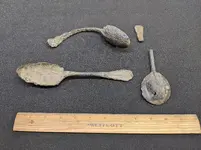
Bent and very crumbly, but unmistakably a rat-tail pewter spoon. Both of these would have been mid 18th century to around the Rev War period so quite early for my area. There were a couple more fragments including a larger bowl rat-tail spoon, but everything was in a very small radius so it seems I stumbled on a third homesite in this little stretch!
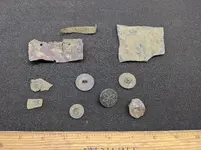
Early buttons including a drilled shank tombac seem to confirm the date range and oddly I found numerous fragments of worked copper sheet. There were also a surprising number of copper coins for such a small area:
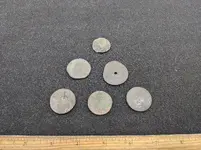
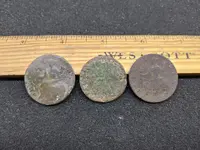
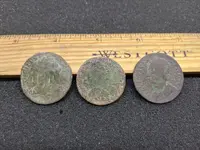
Not in the best of shape, but the three most recognizable were a counterfeit King George III half penny, a decent 1749 King George II half penny, and a Vermont Copper. It's funny, I didn't think much of the Vermont Copper at first since it wasn't in very good shape. It was actually on the surface, but even still the patina was partially gone. I was looking at it under magnification and assumed trying to attribute a die was a waste of time, but there was an odd line going through the reverse impression.
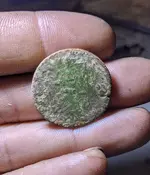

I tried to get the lighting to highlight it in the above photos, but it's very hard to see with the mottling of the patina. Anyways, it turns out that the line is a die crack that's diagnostic of the Ryder 26, one of the rarest Vermont Coppers! There are less than 30 known and the condition census example only has "Fine" features. It's a little sad because the obverse of this shows XF to AU details on the bust. If the ground conditions had created a stable patina on both sides this would have been the finest known specimen. Ah well, still an amazing rush when I realized what it was!
There are less than 30 known and the condition census example only has "Fine" features. It's a little sad because the obverse of this shows XF to AU details on the bust. If the ground conditions had created a stable patina on both sides this would have been the finest known specimen. Ah well, still an amazing rush when I realized what it was!
As cool as that is, it may still not be the best find of the day. I got a large signal right on the surface and given this spot I was sure it was beer can lid number 42, but instead it was a large piece of brass;
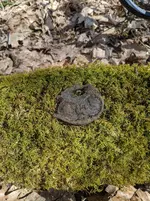
I could see a design through the dirt, but I figured it was a piece of horse brass even though the shape was odd. It wasn't until I cleaned it up that I saw the square hole and realized it was a sword guard!
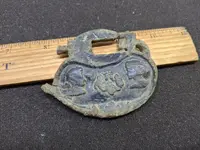
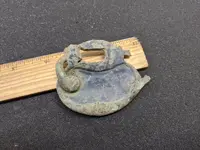
Not only is it my first sword guard, but it's quite the unique design too! There are the two busts, male and female, and between them appears to be two figures. I gather from my research that small swords were popular accessories amongst fashionable men (of means) in the 18th century. Below is an intact example and you can see the little ball-ended stalk similar to the one on my example:
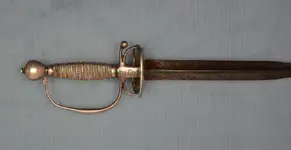
While many of the swords had decorated guards, I've been unable to find a match to this one and I suspect that it's commemorating a royal marriage or some other similar event. I'm hoping some of the sword experts here have seen a similar example and could shed some light on it!
In any case this was an extraordinary hunt and gives me hope that there are more little foundations in this area waiting to be found!
Update:
I now have a confirmed ID for this sword guard and it's much older than I thought and if possible, even cooler!!!
So for starters, the two busts are actually William and Mary as in the British monarchs at the end of the 17th century! It was Iron Patch that suggested this and I did some searching around and first found a commemorative medal made to celebrate their coronation that looked similar:
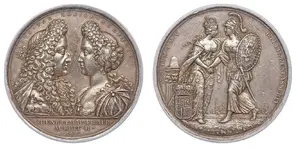
And then after much searching online I found a surviving example of the sword that confirms it!

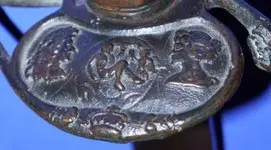
The site with the sword had this in the description:
So there you have it; this is well over 325 years old! This area wasn't even settled until the 1750's so it was probably an heirloom by the time it was lost and who knows, maybe even the children or grandchildren of a British military officer. Talk about a once in a lifetime find!!!!
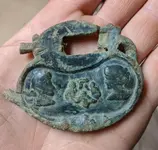
Didn't have a lot of time to detect and I wasn't expecting to find much. There's a spot in the hills I found a year or so back with two 18th century foundations right next to an old road and maybe 150 feet apart. Both had been detected before, but they're super trashy since they were a party spot in the 60s so I usually find a mid tone or two that actually end up being old.
This time I was checking the ground between the two which I was hoping would have had a little traffic 200 years ago. Almost in the middle of the two was a weird single line pile of rocks and right next to that pile I pulled out a super deep high tone:

An intact 18th century pewter spoon! I had been expecting a large chunk of iron so it's a small miracle that I didn't break this pulling it out. Whole spoons from this period are exceptionally rare to find so imagine my surprise when I pulled out a second:

Bent and very crumbly, but unmistakably a rat-tail pewter spoon. Both of these would have been mid 18th century to around the Rev War period so quite early for my area. There were a couple more fragments including a larger bowl rat-tail spoon, but everything was in a very small radius so it seems I stumbled on a third homesite in this little stretch!

Early buttons including a drilled shank tombac seem to confirm the date range and oddly I found numerous fragments of worked copper sheet. There were also a surprising number of copper coins for such a small area:



Not in the best of shape, but the three most recognizable were a counterfeit King George III half penny, a decent 1749 King George II half penny, and a Vermont Copper. It's funny, I didn't think much of the Vermont Copper at first since it wasn't in very good shape. It was actually on the surface, but even still the patina was partially gone. I was looking at it under magnification and assumed trying to attribute a die was a waste of time, but there was an odd line going through the reverse impression.


I tried to get the lighting to highlight it in the above photos, but it's very hard to see with the mottling of the patina. Anyways, it turns out that the line is a die crack that's diagnostic of the Ryder 26, one of the rarest Vermont Coppers!
 There are less than 30 known and the condition census example only has "Fine" features. It's a little sad because the obverse of this shows XF to AU details on the bust. If the ground conditions had created a stable patina on both sides this would have been the finest known specimen. Ah well, still an amazing rush when I realized what it was!
There are less than 30 known and the condition census example only has "Fine" features. It's a little sad because the obverse of this shows XF to AU details on the bust. If the ground conditions had created a stable patina on both sides this would have been the finest known specimen. Ah well, still an amazing rush when I realized what it was!As cool as that is, it may still not be the best find of the day. I got a large signal right on the surface and given this spot I was sure it was beer can lid number 42, but instead it was a large piece of brass;

I could see a design through the dirt, but I figured it was a piece of horse brass even though the shape was odd. It wasn't until I cleaned it up that I saw the square hole and realized it was a sword guard!


Not only is it my first sword guard, but it's quite the unique design too! There are the two busts, male and female, and between them appears to be two figures. I gather from my research that small swords were popular accessories amongst fashionable men (of means) in the 18th century. Below is an intact example and you can see the little ball-ended stalk similar to the one on my example:

While many of the swords had decorated guards, I've been unable to find a match to this one and I suspect that it's commemorating a royal marriage or some other similar event. I'm hoping some of the sword experts here have seen a similar example and could shed some light on it!
In any case this was an extraordinary hunt and gives me hope that there are more little foundations in this area waiting to be found!
Update:
I now have a confirmed ID for this sword guard and it's much older than I thought and if possible, even cooler!!!

So for starters, the two busts are actually William and Mary as in the British monarchs at the end of the 17th century! It was Iron Patch that suggested this and I did some searching around and first found a commemorative medal made to celebrate their coronation that looked similar:

And then after much searching online I found a surviving example of the sword that confirms it!


The site with the sword had this in the description:
With the heads of King William III (England) / II (Scotland) and Queen Mary II who jointly reigned from 1689 to 1694, embossed to the guard. The blade bears the "Kings Head Mask" which some thought depicted the previous King James II / VII, but this sword tends to prove that it is actually a Solingen (Prussia) maker's mark. These swords were designed as hunting swords but were also used by naval and even army officers.
So there you have it; this is well over 325 years old! This area wasn't even settled until the 1750's so it was probably an heirloom by the time it was lost and who knows, maybe even the children or grandchildren of a British military officer. Talk about a once in a lifetime find!!!!

Amazon Forum Fav 👍
Last edited:
Upvote
34




